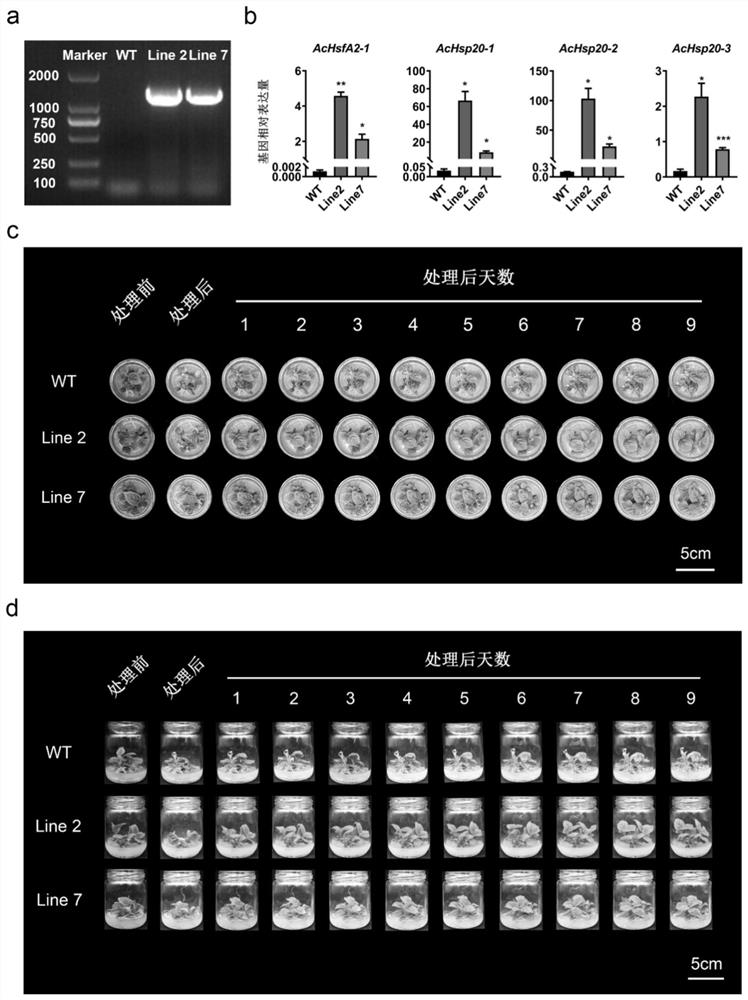Kiwi fruit germplasm material resistant to extreme high-temperature growth conditions and cultivation method
A technology for high-temperature growth and kiwifruit, applied in biochemical equipment and methods, chemical instruments and methods, and botanical equipment and methods, etc., can solve the problems of decreased pollen germination rate, increased reactive oxygen species, decreased antioxidant enzyme activity, etc. The effect of easy promotion and application, reasonable design and convenient operation
- Summary
- Abstract
- Description
- Claims
- Application Information
AI Technical Summary
Problems solved by technology
Method used
Image
Examples
Embodiment 1
[0013] (1) Research methods
[0014] 1. High temperature stress treatment of common kiwifruit plants: select vigorous common kiwifruit tissue culture seedlings grown in 1 / 2MS rooting medium, and inoculate 3 plants in each bottle as three biological replicates. The plants were placed in a constant temperature oven at 50°C to simulate natural high temperature stress conditions for 2 hours. Then the plants were re-placed in a tissue culture room at 20°C, cultured normally, and the phenotype changes were observed.
[0015] (2) Research results
[0016] After 2 hours of extreme high temperature treatment at 50°C, the leaves of common kiwifruit plants wilted and withered, and some leaves fell off; within 9 days after the high temperature treatment was eliminated, the plants were still in a state of wilting, withering, sluggish growth, and basically lost vitality (attached figure 1 c and 1d).
Embodiment 2
[0018] (1) Research methods
[0019] 1. Cloning of heat shock transcription factor AcHsfA2-1
[0020] The heat shock transcription factor AcHsfA2-1 was cloned by using ordinary PCR technology, using the cDNA of the leaf of Actinidia sinensis 'Donghong' as a template, and applying the primers whose sequences are SEQ NO.3 and SEQ NO.4. PCR system includes 15μL MaxBuffer, 1.2μL SEQ NO.3 primer, 1.2μL SEQ NO.4 primer, 0.6μL dNTP Mix (10mM each), 0.6μL Max Super-Fidelity DNA Polymerase, 1 μL cDNA template, 10.4 μL nuclease-free water for a total volume of 30 μL. The PCR program was: 5min at 95°C, 38 thermal cycles (95°C for 15s, 58°C for 15s, 72°C for 90s), 5min at 72°C, and terminated.
[0021] 2. Expression vector construction
[0022] After agarose gel electrophoresis, separation, and purification of the above PCR products, they are loaded into an expression vector that can be used for plant genetic transformation, which can be any commercial expression vector. The connec...
PUM
 Login to View More
Login to View More Abstract
Description
Claims
Application Information
 Login to View More
Login to View More - R&D
- Intellectual Property
- Life Sciences
- Materials
- Tech Scout
- Unparalleled Data Quality
- Higher Quality Content
- 60% Fewer Hallucinations
Browse by: Latest US Patents, China's latest patents, Technical Efficacy Thesaurus, Application Domain, Technology Topic, Popular Technical Reports.
© 2025 PatSnap. All rights reserved.Legal|Privacy policy|Modern Slavery Act Transparency Statement|Sitemap|About US| Contact US: help@patsnap.com

